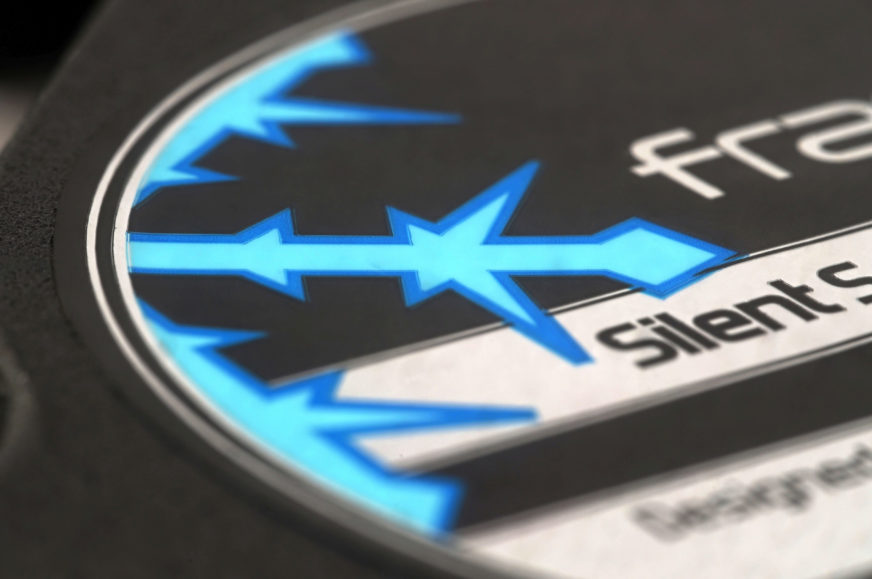Evaluation
An older, even old, but still relevant fan. The selection among cheaper, 140mm models is quite small and when you look at the design of the Silent R3, it looks quite good at first glance, even technically. Moreover, it is a slower-speed fan, which doesn’t automatically mean that it avoids resonant frequencies, but it does promise to run rather quietly. And at those lower noise levels, also an attractive price/cooling performance ratio.
Evaluation
The 140mm Fractal Design Silent R3 may be old news, but it’s still a sensible option among cheaper fans. The price-to-airflow ratio at comparable noise levels, however, is sometimes even higher than with the Endorfy Fluctus 140 PWM. This is typically in non-restrictive systems without obstacles at higher (~600+ rpm) than low speed (i.e. ~500 rpm or less), at which there is already “a lot” of motor noise in the sound. But don’t take that to mean it’s noisy. It is indeed noisier than the Fluctus fans, but compared to the Prisma AL-14 PWM fans, it is significantly quieter.
And it’s quieter, too, compared to the Dynamic X2 GP-12 PWM, as you can see in the spectrograms. In these, focus on the pitch of the tonal peaks in the band between 1 and 2 kHz – Silent R3, Dynamic X2 GP-12 PWM and Prisma AL-14 PWM. In this respect, the Silent R3 performs very well and is a hair better than the Fluctus 140 PWM when it comes to lower, rumbling frequencies. These also are present in the Silent R3, but they are more pronounced in the upper half of the speed range, from 750 rpm upwards.
Vibrations do occur on the blades, and while they are strong enough to have a negative impact on the sound, they don’t reach the frame. Their intensity is too weak for that. So you don’t have to worry about secondary noise from resonant frequencies caused by an obstacle with which they are in contact. Partly because there are some tonal peaks shaped by the obstacle from the airflow.
For example, on a hexagonal grille, the 140 mm Silent R3 likes lower RPM. At higher speeds, the more annoying “hum” at 359 Hz starts to show up. But the slower running suits this Fractal Design fan, even on a plastic filter, with which there is exceedingly little noise at the “rustling” frequencies (4.5 – 7.5 kHz) that it stimulates.
However, it should also be added that from a performance point of view the Silent R3 already somehow lacks static pressure even for a plastic filter. It can be great as a system fan, within the low-end budget category, but with a nylon filter. Even the Fluctuses may not be compatible with it, unless it has a thicker frame or is a center-reinforced model. On a grille, however, the Silent R3 doesn’t really stand out anymore, and it’s lagging behind the Fluctus 140 PWM by a good chunk, much like on a radiator. Static pressure is simply lower, also because of the larger area of void space around the rotor where the air leaks out.
But again, as a case fan behind a nylon filter or preferably in a free, unrestricted space, the Silent R3 is well worth considering even now. That is, unless you don’t mind DC-only control.
Note also the worse “truthfulness” coefficient of the parameters, especially in terms of airflow. Already based on the results of the Prisma AL-14 PWM, which was said to deliver significantly higher airflow at equal speeds than the Aspect 14 RGB PWM with an identical rotor, Fractal Design did a bit of a run-up, and based on the Silent R3 results, it seems that they were something wrong with the older measurements. Again, the real airflow here is lower than the paper specs say. These should apply to a speed of 1000 rpm (which, as you already know, you don’t normally get to), but even after setting it, 78,26 m3/h is quite a ways away from the stated 95,31 m3/h. However, it’s nothing particularly important and we’re bringing it to light just to make everything clear.
The golden era of the Silent R3 seems to be over, in many aspects (including power efficiency) this fan has already been surpassed. Considering the price of around 12 EUR, it matches well with the current competition in some scenarios and as long as you take advantage of the Silent R3’s strengths while knowing its weaknesses (and avoiding them), you don’t have to be reluctant to put it in your shopping cart.
English translation and edit by Jozef Dudáš
| Fractal Design Silent R3 140 mm |
| + Suitable for every use case |
| + Low price... |
| + ... and a very attractive price/airflow ratio |
| + Cooling efficiency (airflow/pressure per unit of noise) at a high level... |
| + ... beats even high-end 120 mm fans in a no-obstacle environment |
| + Relatively low airflow drop through a fine dust filter |
| + Very low speeds possible, stable from approx. 134 rpm |
| + Virtually noiseless operation of bearings and motor |
| + Extra-low, negligible vibrations in terms of the frame |
| + At lower speeds (below 700 rpm) pleasantly quiet... |
| - ... at higher speeds (above 750 rpm), however, the sound is characterized by more rumbling frequencies |
| - Weaker maximum airflow given by lower speeds... |
| - ... with 12.0 V it does not reach even the specified 1000 rpm |
| - DC control only |
| Approximate retail price: 12 EUR |
- Contents
- Fractal Design Silent R3 140 mm in detail
- Overview of manufacturer specifications
- Basis of the methodology, the wind tunnel
- Mounting and vibration measurement
- Initial warm-up and speed recording
- Base 6 equal noise levels…
- ...and sound color (frequency characteristic)
- Static pressure measurement…
- … and airflow
- Everything changes with obstacles
- How we measure power draw and motor power
- Measuring the intensity (and power draw) of lighting
- Results: Speed
- Results: Airlow w/o obstacles
- Results: Airflow through a nylon filter
- Results: Airflow through a plastic filter
- Results: Airflow through a hexagonal grille
- Results: Airflow through a thinner radiator
- Results: Airflow through a thicker radiator
- Results: Static pressure w/o obstacles
- Results: Static pressure through a nylon filter
- Results: Static pressure through a plastic filter
- Results: Static pressure through a hexagonal grille
- Results: Static pressure through a thinner radiator
- Results: Static pressure through a thicker radiator
- Results: Static pressure, efficiency by orientation
- Reality vs. specifications
- Results: Frequency response of sound w/o obstacles
- Results: Frequency response of sound with a dust filter
- Results: Frequency response of sound with a hexagonal grille
- Results: Frequency response of sound with a radiator
- Results: Vibration, in total (3D vector length)
- Results: Vibration, X-axis
- Results: Vibration, Y-axis
- Results: Vibration, Z-axis
- Results: Power draw (and motor power)
- Results: Cooling performance per watt, airflow
- Results: Cooling performance per watt, static pressure
- Airflow per euro
- Static pressure per euro
- Results: Lighting – LED luminance and power draw
- Results: LED to motor power draw ratio
- Evaluation













I think the R3 series were released in 2016, which aren’t too old all things considered. The lack of PWM control and low top speed probably makes them look more dated than they really are.
I had experience with the even older R2 models (included with the Node 304 case) which I couldn’t recall being noisy either, those I believe were released back in 2012 (and is still included in older case designs!)
Maybe a little earlier? On TPU there is a message about the release of Silent R3 fans from February 2015. But the NH-D15 is still a year older, even though it may not look like that, which is probably because it still has no successor and at the same time the cooler is still on the top? Personally, I also consider NF-A15 fans to be dinosaurs and Noctua desperately needs a refresh in this format, which we are so looking forward to. 🙂
Although 3-pin fans seem to be a bit outdated from a desktop point of view, I suppose from time to time some new models will appear with DC control. These can probably be made a bit cheaper… as they don’t need the PWM IC.
Don’t you remember how the R2 (we probably won’t test those anymore :)) were with motor noise? Also above standard silent, not rattling? It is possible that FD started to “neglect” fans in this respect only from Dynamic models onwards, then it went even harder with Prismas, where it was apparently (also based on user feedback) such a failure that with Aspects, there was no saving in this respect again. Their motor does not rattle, at least with the 140mm PWM variant. But perhaps this could be a common feature across all variants (of Aspects).
To be honest I have only had very limited time with the Node 304 (and the three Silent R2 fans, two 92 mm and one 140), so don’t fully trust my words. I remember not being able to hear the PC running at all when I first turned it on though (my ears were held somewhere close to the middle of the case with panels closed, not near the fans). I think there were 2-3 fan speed settings that could be toggled at the back of the case, where the highest setting is barely noticeable and the lower settings basically inaudible. Anandtech and Silent PC Review both praised the Node 304 for its silence (which is why I chose the case in the first place) so it’s very possible that the fans indeed do not emit annoying noises.
It is good to see the seperated results of 140mm and 120mm.
It seems that Silent R3 can be summarized as, low efficiency, low max performance and low noise. Actually, I don’t like this type of fans, because the feature of ‘3L’ really doesn’t offer any meaningful merits.
But still, if the comparison is only set as stock fans of a case, Fractal’s fans can be regarded as decent fans. They have silent driving noise and good build quality.
I understand and I also find it hard to find any advantages on fans with lower maximum speeds. Especially if it’s a comparison with models that have high (and noisy top speeds) rpm, but at the same time have a very wide range, so they can be slowed down considerably. But maybe we are looking at it from the point of view of users who like to adapt and tune things? For those who don’t get excited about this and just want to plug and play, maybe the advantage of low-maximum-speed fans is that the operation will never be too noisy, regardless of how the motherboard has the default speed curve set? If it has an aggressive curve, then liquid coolers with typically high speed fans (even with 2250+ rpm) are quite inefficient, as the cooling performance does not scale much with the higher than standard airflow.
DC fans with lower max. speeds can find good application in devices without the possibility of regulation. In such, which are powered from a single, 12 V branch, similar to, for example, 24 V 3D printers? But again, in modern desktops, with wide possibilities of adaptation and control by linear voltage, I also don’t see it as something to go for. Most of the boards also have, moreover, something like a “silent” mode with reduced PWM duty cycle and perhaps a fixed voltage in the default settings for speed control of the system headers, as long as there are DC-only models.
Usability of low speed fans are these nowadays almost oldschool switchable fan controllers on cases which used to be rather standard 5-10 years ago. They usually have just two or three speeds to choose and with fast fans it just works bad – too much difference between modes and usually all too loud.
Case manufacturers want to satisfy the needs of a wider range of users while reducing costs to an appropriate level. I think this is why manufacturers include this type of fans on their cases. Of course, I understand the point of view of users who aren’t interested in moding(even including entering to UEFI) and some applications(i.e. a water purifier) that need a low airflow without any control.
Personally, I hope case manufacturers release some cases without any stock fans or with fans(such as Arctic P12) which have a high efficiency and low max performance. Of course, the commercial potential of such products is not so great, so I think it is unlikely that they will appear on the market.